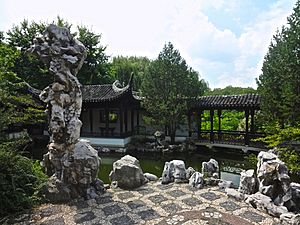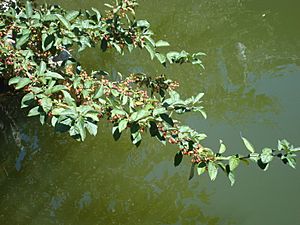New York Chinese Scholar's Garden facts for kids
The New York Chinese Scholar's Garden (also known as Jìxīng Yuán in Chinese) is a special part of the Staten Island Botanical Garden. You can find it within the Snug Harbor Cultural Center in Staten Island. This amazing garden was built by a team of 40 skilled Chinese artists and craftspeople from Suzhou. They shipped all the materials to Staten Island in the spring of 1998, and the garden officially opened in June of 1999.
The idea for an authentic Chinese garden in New York started way back in 1984. Frances Paulo Huber, who was the president of the Botanical Garden, saw the need for such a beautiful place. Many groups helped make this dream come true. These included the Staten Island Botanical Garden, the City of New York, a Chinese landscape design company, the local Chinese American community, and many generous people and companies. After a lot of teamwork, a contract was signed with the Landscape Architecture Corporation of China. Mr. Zou Gongwu was chosen as the main designer for the project.
Contents
What Makes a Chinese Scholar's Garden Special?
Chinese scholar's gardens are designed to be very elegant and peaceful. The Chinese word for this elegance is ya (雅). When you enter the garden, you usually walk through a narrow path. This helps you calm your mind before you step into the main garden area. The way the garden is designed creates a feeling of peace and balance. It makes a small space feel much bigger and never-ending.
How Do Designers Create Space?
Garden designers use clever tricks to make the garden feel larger and more exciting.
- The borrowed view makes the garden seem to stretch beyond its actual borders. It uses things outside the garden as part of the view.
- The hidden view adds surprise! As you walk deeper into the garden, new parts are slowly revealed, making you curious about what's next.
- The opposite view is like a framed picture. You might see it perfectly framed by a special moon gate or a pretty window shaped like a flower.
Key Parts of a Chinese Garden
Every part of a Chinese garden is chosen carefully and has a special meaning.
- Wood: In traditional Chinese gardens, builders don't use nails or glue! Instead, wooden pieces are joined together using a very old and clever system called "mortise-and-tenon." This method was common during the Ming Dynasty in China.
- Rocks: Rocks are very important in Chinese culture. They are often called the "bones of the earth" in Chinese writings. They represent strength and permanence.
- Water: The garden has three ponds and a waterfall. Water is seen as the "arteries of the world," bringing life and movement to the garden.
- Plants: China has given many beautiful plants to the world, like the rose, lilac, daphne, different kinds of rhododendron, and the peony. Plants in the garden are picked not just for their beauty, but also for their shape, how they change with the seasons, and what they symbolize.
- Furniture: The furniture in the garden, like benches and tables, is sometimes called the "internal organs." This means they are essential for the garden to function and feel complete.
- Walls: Walls are not just for privacy. They are placed in smart ways to guide your eye and create different scenes within the garden.
- Walkways: The paths in the garden are often curved. This allows you to see many different views and angles as you walk.
- Bridges: Bridges and paths often zigzag. This gives visitors new and changing views of the garden. Chinese thinkers also believed that zigzagging paths would confuse and keep away bad spirits!
- Pavilions: There are two pavilions in this garden. One is a quiet place for a scholar to study, and the other offers great views of different parts of the garden.
- Xie: A Xie is a special building that hangs partly over a lake. It's designed to look like it's floating on the water!
- Painting and Calligraphy: You might see paintings and beautiful writing (calligraphy) in the garden. These show that the garden's owner loves literature and art.
Images for kids





